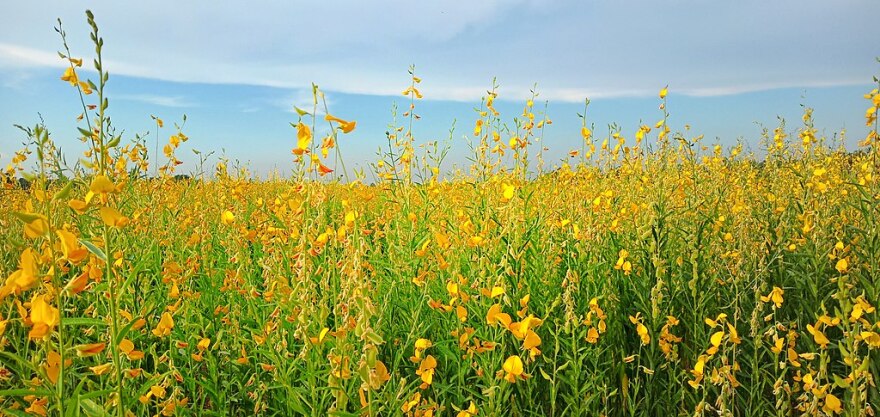Wyoming's harsh climate can be a difficult place for crops to survive, but research from the University of Wyoming shows that sunn hemp, a tropical legume from India that can be used for livestock feed, is actually very well adapted to the state.
"Sunn hemp is a very resilient plant, so it actually is a plant that can handle stress well. It can handle really high temperatures well, it can handle dry conditions and poor soils," said lead researcher Carrie Eberle. "So all of those things are what we experience in Wyoming really from June through the end of August."
She's been growing sunn hemp in southeastern Wyoming since 2016 and at the research station in Sheridan for a few years too. According to Eberle, young sunn hemp plants get water stressed very easily; they prefer to be hot and dry to start, which is well suited to Wyoming. After the first few weeks, Eberle starts watering them more to encourage biomass production, which she said grows fast.
"If you think about that small growing window from June to the end of August, if you're able to get an additional five tons of feed off of your field, that's a pretty good payout for a crop that has a relatively short growing season," she said.
This fast growing characteristic means that sunn hemp could be used as a rescue crop when there isn't enough feed for livestock or when hay prices are high.
"With a crop like alfalfa, you need a full year to get that established and produce good yield. Whereas with a crop like sunn hemp, you're going to get that feed in the same year that you're growing it so you might be able to supplement your livestock and your feed within that season to meet the demand of what you need," said Eberle.
And sunn hemp uses less water than alfalfa, another plus in Eberle's book. She said it's also shown itself to be good feed for cattle.
"I've been working with Dr. Steve Paisley who is a beef cattle extension specialist. And we actually did a steer feeding trial last winter with him to be sure that the cattle would actually eat it, and see how they performed on it. And they did well," said Eberle.
She said now they're working on learning the best ways to grow it for a producer, but it can also just be included in a farmer's regular crop rotation. Sunn hemp helps put nitrogen back into the soil, an important nutrient for many crop plants.
"It would fit in well if someone was growing, say, winter triticale that they are going to hay and bale in the spring when it's in the boot. And then you could come in behind it with sunn hemp and produce a legume crop with a little higher feed value to complement that winter triticale that you're growing. So those two seasons would complement each other very well," she said. "And then because that crop is going to mature fast, you could potentially take it off earlier in the fall and get a winter cover crop put back on for your cattle to graze over the winter."
Eberle said they're still trying to learn more about the best time and way to harvest sunn hemp and the most economical way to get it to livestock. But, she said, seed is available and is common in cover crop mixes, so if farmers wanted to start adding it to their rotation, they could.
"For anybody who has questions about the crop, you are welcome to reach out to myself or Dr. Steve Paisley. We're at the SAREC R&D Center as part of the University of Wyoming, and we are more than happy to discuss the research and talk to you about if the crop is something you would want to try," Eberle said.







